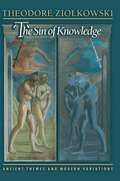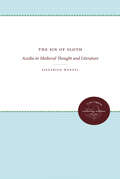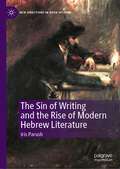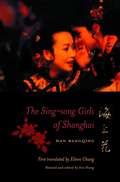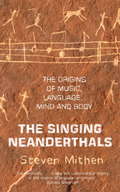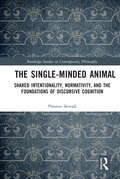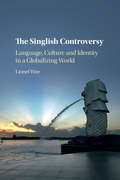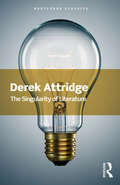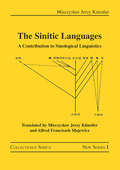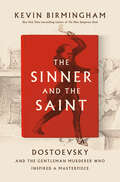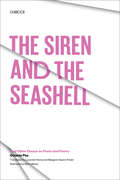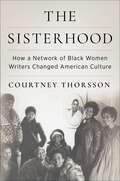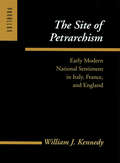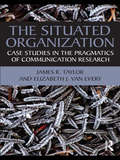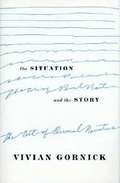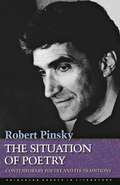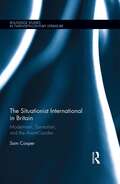- Table View
- List View
The Silver Fork Novel
by Edward CopelandIn the early nineteenth century there was a sudden vogue for novels centering on the glamour of aristocratic social and political life. Such novels, attractive as they were to middle-class readers, were condemned by contemporary critics as dangerously seductive, crassly commercial, designed for the 'masses' and utterly unworthy of regard. Until recently, silver-fork novels have eluded serious consideration and been overshadowed by authors such as Jane Austen. They were influenced by Austen at their very deepest levels, but were paradoxically drummed out of history by the very canon-makers who were using Austen's name to establish their own legitimacy. This first modern full-length study of the silver-fork novel argues that these novels were in fact tools of persuasion, novels deliberately aimed at bringing the British middle classes into an alliance with an aristocratic program of political reform.
The Simple Math of Writing Well: Writing for the 21st Century
by Jennie HarropWriting guides abound, but this book is one of a kind. Readers will find its practical approach affirming, encouraging, and informative, and its focus on the basics of linguistic structure releases 21st-century writers to embrace the variety of mediums that define our internet-connected world. As the author reminds us in the opening chapters of her book, we write more today than ever before in history: texts, emails, letters, blogs, reports, social media posts, proposals, etc. This is the first guide that directly addresses the importance of writing well in the Google age.
The Simple Wordsworth: Studies in the Poems 1979-1807 (RLE: Wordsworth and Coleridge #4)
by John F. DanbyFirst published in 1960, this book studies Wordsworth’s ‘simple’ poems, such as the Lyrical Ballads, as products of a sophisticated and powerfully successful literary genius. The author aims to approach the poems as perhaps Wordsworth expected his first readers to; but as they have never been in fact. The result of this approach is to discover a Wordsworth far different to that which he has previously been presented as — the ‘Sage of Rydal’ at one extreme and a naïve perpetrator of poetical blunders at the other — and, the author argues, a far more exciting one. This book will be of interest to students of literature.
The Sin of Knowledge: Ancient Themes and Modern Variations
by Theodore ZiolkowskiAdam, Prometheus, and Faust--their stories were central to the formation of Western consciousness and continue to be timely cautionary tales in an age driven by information and technology. Here Theodore Ziolkowski explores how each myth represents a response on the part of ancient Hebrew, ancient Greek, and sixteenth-century Christian culture to the problem of knowledge, particularly humankind's powerful, perennial, and sometimes unethical desire for it. This book exposes for the first time the similarities underlying these myths as well as their origins in earlier trickster legends, and considers when and why they emerged in their respective societies. It then examines the variations through which the themes have been adapted by modern writers to express their own awareness of the sin of knowledge. Each myth is shown to capture the anxiety of a society when faced with new knowledge that challenges traditional values. Ziolkowski's examples of recent appropriations of the myths are especially provocative. From Voltaire to the present, the Fall of Adam has provided an image for the emergence from childhood innocence into the consciousness of maturity. Prometheus, as the challenger of authority and the initiator of technological evil, yielded an ambivalent model for the socialist imagination of the German Democratic Republic. And finally, an America unsettled by its responsibility for the atomic bomb, and worrying that in its postwar prosperity it had betrayed its values, recognized in Faust the disturbing image of its soul.
The Sin of Sloth: Acedia in Medieval Thought and Literature
by Siegfried WenzelWenzel presents the history of the concept of acedia, of spiritual sloth," from its origins among the Egyptian desert monks through the Middle Ages to the Renaissance. The investigation proceeds in chronological order and pays close attention to the different emphases and changes the concept underwent.Originally published in 1967.A UNC Press Enduring Edition -- UNC Press Enduring Editions use the latest in digital technology to make available again books from our distinguished backlist that were previously out of print. These editions are published unaltered from the original, and are presented in affordable paperback formats, bringing readers both historical and cultural value.
The Sin of Writing and the Rise of Modern Hebrew Literature (New Directions in Book History)
by Iris ParushThe Sin of Writing and the Rise of Modern Hebrew Literature contends that the processes of enlightenment, modernization, and secularization in nineteenth-century Eastern European Jewish society were marked not by a reading revolution but rather by a writing revolution, that is, by a revolutionary change in this society's attitude toward writing. Combining socio-cultural history and literary studies and drawing on a large corpus of autobiographies, memoirs, and literary works of the period, the book sets out to explain the curious absence of writing skills and Hebrew grammar from the curriculum of the traditional Jewish education system in Eastern Europe. It shows that traditional Jewish society maintained a conspicuously oral literacy culture, colored by fears of writing and suspicions toward publication. It is against this background that the young yeshiva students undergoing enlightenment started to “sin by writing,” turning writing and publication in Hebrew into the cornerstone of their constitution as autonomous, enlightened, male Jewish subjects, and setting the foundations for the rise of modern Hebrew literature.
The Sing-song Girls of Shanghai (Weatherhead Books on Asia)
by Bangqing HanDesire, virtue, courtesans (also known as sing-song girls), and the denizens of Shanghai's pleasure quarters are just some of the elements that constitute Han Bangqing's extraordinary novel of late imperial China. Han's richly textured, panoramic view of late-nineteenth-century Shanghai follows a range of characters from beautiful sing-song girls to lower-class prostitutes and from men in positions of social authority to criminals and ambitious young men recently arrived from the country. Considered one of the greatest works of Chinese fiction, The Sing-song Girls of Shanghai is now available for the first time in English. Neither sentimental nor sensationalistic in its portrayal of courtesans and their male patrons, Han's work inquires into the moral and psychological consequences of desire. Han, himself a frequent habitué of Shanghai brothels, reveals a world populated by lonely souls who seek consolation amid the pleasures and decadence of Shanghai's demimonde. He describes the romantic games played by sing-song girls to lure men, as well as the tragic consequences faced by those who unexpectedly fall in love with their customers. Han also tells the stories of male patrons who find themselves emotionally trapped between desire and their sense of propriety. First published in 1892, and made into a film by Hou Hsiao-hsien in 1998, The Sing-song Girls of Shanghai is recognized as a pioneering work of Chinese fiction in its use of psychological realism and its infusion of modernist sensibilities into the traditional genre of courtesan fiction. The novel's stature has grown with the recent discovery of Eileen Chang's previously unknown translation, which was unearthed among her papers at the University of Southern California. Chang, who lived in Shanghai until 1956 when she moved to California and began to write in English, is one of the most acclaimed Chinese writers of the twentieth century.
The Singing Neanderthals: The Origins of Music, Language, Mind and Body
by Prof Steven MithenA fascinating and incisive examination of our language instinct from award-winning science writer Steven Mithen.Along with the concepts of consciousness and intelligence, our capacity for language sits right at the core of what makes us human. But while the evolutionary origins of language have provoked speculation and impassioned debate, music has been neglected if not ignored. Like language it is a universal feature of human culture, one that is a permanent fixture in our daily lives.In THE SINGING NEANDERTHALS, Steven Mithen redresses the balance, drawing on a huge range of sources, from neurological case studies through child psychology and the communication systems of non-human primates to the latest paleoarchaeological evidence.The result is a fascinating and provocative work and a succinct riposte to those, like Steven Pinker, who have dismissed music as a functionless and unimportant evolutionary byproduct.
The Singing Neanderthals: The Origins of Music, Language, Mind and Body
by Steven MithenA fascinating and incisive examination of our language instinct from award-winning science writer Steven Mithen.Along with the concepts of consciousness and intelligence, our capacity for language sits right at the core of what makes us human. But while the evolutionary origins of language have provoked speculation and impassioned debate, music has been neglected if not ignored. Like language it is a universal feature of human culture, one that is a permanent fixture in our daily lives.In THE SINGING NEANDERTHALS, Steven Mithen redresses the balance, drawing on a huge range of sources, from neurological case studies through child psychology and the communication systems of non-human primates to the latest paleoarchaeological evidence.The result is a fascinating and provocative work and a succinct riposte to those, like Steven Pinker, who have dismissed music as a functionless and unimportant evolutionary byproduct.
The Single Woman, Modernity, and Literary Culture
by Emma SterryThis book situates the single woman within the evolving landscape of modernity, examining how she negotiated rural and urban worlds, explored domestic and bohemian roles, and traversed public and private spheres. In the modern era, the single woman was both celebrated and derided for refusing to conform to societal expectations regarding femininity and sexuality. The different versions of single women presented in cultural narratives of this period--including the old maid, odd woman, New Woman, spinster, and flapper--were all sexually suspicious. The single woman, however, was really an amorphous figure who defied straightforward categorization. Emma Sterry explores depictions of such single women in transatlantic women's fiction of the 1920s to 1940s. Including a diverse selection of renowned and forgotten writers, such as Djuna Barnes, Rosamond Lehmann, Ngaio Marsh, and Eliot Bliss, this book argues that the single woman embodies the tensions between tradition and progress in both middlebrow and modernist literary culture.
The Single-Minded Animal: Shared Intentionality, Normativity, and the Foundations of Discursive Cognition (Routledge Studies in Contemporary Philosophy)
by Preston StovallThis book provides an account of discursive or reason-governed cognition, by synthesizing research in the philosophy of language, the philosophy of mind, and evolutionary anthropology. Using the grasp of a natural language as a model for the autonomous or self-governed rationality of discursive cognition, the author uses a semantics for individual intentions, shared intentions, and normative attitudes as a framework for understanding what it is to be a rational animal. This semantics interprets claims about shared intentions and claims about what people ought and may do as the expression of plans of action that involve taking the points of view of other people within a community. This has important consequences for our understanding of both the natural basis and the social relevance of intentional and normative mental states. In order to distinguish the strong and weak modal force, which characterizes normativity but not shared intentionality, the author argues that a notion of single-minded practical cognition is necessary. This account of single-mindedness is then used to shed light on the autonomy or self-government characteristic of discursive cognition, as manifest in a linguistic community whose members are able to adopt the standpoints of others. Drawing together research in philosophy and the related sciences, the formal account of the semantic content of the claims we use to give expression to shared intentional and normative mental states integrates well with research in cognitive science, evolutionary anthropology, and social psychology concerning the ontogenetic and phylogenetic development of shared intentionality and norm psychology in human beings and other primates. The Single-Minded Animal will appeal to researchers and advanced students working on shared intentionality, normativity, rationality, cognitive science, social and developmental psychology, and evolutionary anthropology.
The Singlish Controversy: Language, Culture and Identity in a Globalizing World
by Lionel WeeSinglish is the colloquial variety of English spoken in Singapore. It has sparked much public debate, but so far the complex question of what Singlish really is and what it means to its speakers has remained obscured. This important work explores some of the socio-political controversies surrounding Singlish, such as the political ideologies inherent in Singlish discourse, the implications of being restricted to Singlish for those speakers without access to standard English, the complex relationship between Singlish and migration, and the question of whether Singlish is an asset or a liability to Singaporeans. These questions surrounding Singlish illustrate many current issues in language, culture and identity in an age of rapid change. The book will be of interest to scholars and advanced students of World Englishes and sociolinguistics. Its detailed analysis of the Singlish controversy will illuminate broader questions about language, identity and globalization.
The Singularity of Literature (Routledge Classics)
by Derek AttridgeThe Iliad and Beowulf provide rich sources of historical information. The novels of Henry Fielding and Henry James may be instructive in the art of moral living. Some go further and argue that Emile Zola and Harriet Beecher Stowe played a part in ameliorating the lives of those existing in harsh circumstances. However, as Derek Attridge argues in this outstanding and acclaimed book, none of these capacities is distinctive of literature. What is the singularity of literature? Do the terms "literature" and "the literary" refer to actual entities found in cultures at certain times, or are they merely expressions characteristic of such cultures? Attridge argues that this resistance to definition and reduction is not a dead end, but a crucial starting point from which to explore anew the power and practices of Western art. Derek Attridge provides a rich new vocabulary for literature, rethinking such terms as "invention," "singularity," "otherness," "alterity," "performance" and "form." He returns literature to the realm of ethics, and argues for the ethical importance of literature, demonstrating how a new understanding of the literary might be put to work in a "responsible," creative mode of reading. The Singularity of Literature is not only a major contribution to the theory of literature, but also a celebration of the extraordinary pleasure of the literary, for reader, writer, student or critic. This Routledge Classics edition includes a new preface by the author.
The Sinitic Languages: A Contribution to Sinological Linguistics (Collectanea Serica. New Series #1)
by Mieczysław Jerzy KünstlerThe Sinitic Languages is the quintessence of Mieczysław Jerzy Künstler’s thirty years of research into the Chinese languages. Originally published in Polish in 2000 as Języki chińskie, this work collected Künstler’s various lectures on the fascinating world of this branch of the Sino-Tibetan language family. It marked the apogee of linguistic research of Chinese languages in Poland. With a keen, intuitive understanding of the workings of these languages, Künstler introduces his readership to the historical development of spoken Sinitic languages. Besides analyzing the various stages of Standard Chinese, he also makes a convincing case for classifying Cantonese, Pekinese, Nankinese, Minnanese, Wu, and other so-called "dialects" as distinct languages. Künstler’s work offers an insightful and detailed overview about synchronic and diachronic research on the major language groups of Chinese, a fast growing academic field until today. The present English version was begun by Künstler himself before his untimely demise in 2007. However, it is not merely a translation of the Polish work, but a revised edition that introduces a shift in Sinological linguistics from a genetic to an areal description of Modern Chinese languages. A joint effort of the Polish linguist Alfred Franciszek Majewicz and the Sinologists Ewa Zajdler and Maria Kurpaska helped to bring the original manuscript to its completion. Thus, The Sinitic Languages is now finally accessible for a larger readership. Both amateurs and experts interested in this topic are invited to follow Künstler on his intellectual journey into Sinological linguistics. Künstler intentionally excluded Chinese characters from his work because he viewed the Sinitic languages primarily as spoken languages. In order to provide readers with the opportunity to compare spoken and written language, the editors added an index with glossary to the English version.
The Sinner and the Saint: Dostoevsky and the Gentleman Murderer Who Inspired a Masterpiece
by Kevin BirminghamFrom the New York Times bestselling author of THE MOST DANGEROUS BOOK, the true story behind the creation of another masterpiece of world literature, Fyodor Dostoevsky's CRIME AND PUNISHMENT. *Featured in the Chicago Tribune's Great 2021 Fall Book Preview*THE SINNER AND THE SAINT is the deeply researched and immersive tale of how Dostoevsky came to write this great murder story—and why it changed the world. As a young man, Dostoevsky was a celebrated writer, but his involvement with the radical politics of his day condemned him to a long Siberian exile. There, he spent years studying the criminals that were his companions. Upon his return to St. Petersburg in the 1860s, he fought his way through gambling addiction, debilitating debt, epilepsy, the deaths of those closest to him, and literary banishment to craft an enduring classic. The germ of CRIME AND PUNISHMENT came from the sensational story of Pierre François Lacenaire, a notorious murderer who charmed and outraged Paris in the 1830s. Lacenaire was a glamorous egoist who embodied the instincts that lie beneath nihilism, a western-influenced philosophy inspiring a new generation of Russian revolutionaries. Dostoevsky began creating a Russian incarnation of Lacenaire, a character who could demonstrate the errors of radical politics and ideas. His name would be Raskolnikov. Lacenaire shaped Raskolnikov in profound ways, but the deeper insight, as Birmingham shows, is that Raskolnikov began to merge with Dostoevsky. Dostoevsky was determined to tell a murder story from the murderer's perspective, but his character couldn't be a monster. No. The murderer would be chilling because he wants so desperately to be good. The writing consumed Dostoevsky. As his debts and the predatory terms of his contract caught up with him, he hired a stenographer to dictate the final chapters in time. Anna Grigorievna became Dostoevsky's first reader and chief critic and changed the way he wrote forever. By the time Dostoevsky finished his great novel, he had fallen in love. Dostoevsky's great subject was self-consciousness. CRIME AND PUNISHMENT advanced a revolution in artistic thinking and began the greatest phase of Dostoevsky's career. THE SINNER AND THE SAINT now gives us the thrilling and definitive story of that triumph.
The Sino-Japanese War and Youth Literature: Friends and Foes on the Battlefield (Routledge Studies in Education and Society in Asia)
by Minjie ChenThe Sino-Japanese War (1937 – 1945) was fought in the Asia-Pacific theatre between Imperial Japan and China, with the United States as the latter’s major military ally. An important line of investigation remains, questioning how the history of this war has been passed on to post-war generations’ consciousness, and how information sources, particularly those exposed to young people in their formative years, shape their knowledge and bias of the conflict as well as World War II more generally. This book is the first to focus on how the Sino-Japanese War has been represented in non-English and English sources for children and young adults. As a cross-cultural study and an interdisciplinary endeavour, it not only examines youth-orientated publications in China and the United States, but also draws upon popular culture, novelists’ memoirs, and family oral narratives to make comparisons between fiction and history, Chinese and American sources, and published materials and private memories of the war. Through quantitative narrative analysis, literary and visual analysis, and socio-political critique, it shows the dominant pattern of war stories, traces chronological changes over the seven decades from 1937 to 2007, and teases out the ways in which the history of the Sino-Japanese War has been constructed, censored, and utilized to serve shifting agendas. Providing a much needed examination of public memory, literary representation, and popular imagination of the Sino-Japanese War, this book will have huge interdisciplinary appeal, particularly for students and scholars of Asian history, literature, society and education.
The Siren and the Seashell: And Other Essays on Poets and Poetry (Texas Pan American Series)
by Octavio PazOctavio Paz has long been known for his brilliant essays as well as for his poetry. Through the essays, he has sought to confront the tensions inherent in the conflict between art and society and to achieve a unity of their polarities. The Siren and the Seashell is a collection of Paz’s essays, focusing on individual poets and on poetry in general. The first five poets he treats are Latin American: Sor Juana Inés de la Cruz, Rubén Darío, José Juan Tablada, Ramón López Velarde, and Alfonso Reyes. Then there are essays on Robert Frost, e. e. cummings, Saint-John Perse, Antonio Machado, and Jorge Guillén. Finally, there are Paz’s reflections on the poetry of solitude and communion and the literature of Latin America. Each essay is more than Paz’s impressions of one person or issue; each is the occasion for a wider discussion of cultural, historical, psychological, and philosophical themes. The essays were selected from Paz’s writing between 1942 and 1965 and provide an overview of the development of his thinking and an exploration of the ideas central in his works.
The Siren and the Seashell: And Other Essays on Poets and Poetry (Texas Pan American Series)
by Octavio PazOctavio Paz has long been known for his brilliant essays as well as for his poetry. Through the essays, he has sought to confront the tensions inherent in the conflict between art and society and to achieve a unity of their polarities. The Siren and the Seashell is a collection of Paz's essays, focusing on individual poets and on poetry in general. The first five poets he treats are Latin American: Sor Juana Inés de la Cruz, Rubén Darío, José Juan Tablada, Ramón López Velarde, and Alfonso Reyes. Then there are essays on Robert Frost, e. e. cummings, Saint-John Perse, Antonio Machado, and Jorge Guillén. Finally, there are Paz's reflections on the poetry of solitude and communion and the literature of Latin America. Each essay is more than Paz's impressions of one person or issue; each is the occasion for a wider discussion of cultural, historical, psychological, and philosophical themes. The essays were selected from Paz's writing between 1942 and 1965 and provide an overview of the development of his thinking and an exploration of the ideas central in his works.
The Sisterhood of the Traveling Pants (SparkNotes Literature Guide Series)
by SparkNotesThe Sisterhood of the Traveling Pants (SparkNotes Literature Guide) by Ann Brashares Making the reading experience fun! Created by Harvard students for students everywhere, SparkNotes is a new breed of study guide: smarter, better, faster. Geared to what today's students need to know, SparkNotes provides: *Chapter-by-chapter analysis *Explanations of key themes, motifs, and symbols *A review quiz and essay topicsLively and accessible, these guides are perfect for late-night studying and writing papers
The Sisterhood: How a Network of Black Women Writers Changed American Culture
by Courtney ThorssonOne Sunday afternoon in February 1977, Toni Morrison, Alice Walker, Ntozake Shange, and several other Black women writers met at June Jordan’s Brooklyn apartment to eat gumbo, drink champagne, and talk about their work. Calling themselves “The Sisterhood,” the group—which also came to include Audre Lorde, Paule Marshall, Margo Jefferson, and others—would get together once a month over the next two years, creating a vital space for Black women to discuss literature and liberation.The Sisterhood tells the story of how this remarkable community transformed American writing and cultural institutions. Drawing on original interviews with Sisterhood members as well as correspondence, meeting minutes, and readings of their works, Courtney Thorsson explores the group’s everyday collaboration and profound legacy. The Sisterhood advocated for Black women writers at trade publishers and magazines such as Random House, Ms., and Essence, and eventually in academic departments as well—often in the face of sexist, racist, and homophobic backlash. Thorsson traces the personal, professional, and political ties that brought the group together as well as the reasons for its dissolution. She considers the popular and critical success of Sisterhood members in the 1980s, the uneasy absorption of Black feminism into the academy, and how younger writers built on the foundations the group laid. Highlighting the organizing, networking, and community building that nurtured Black women’s writing, this book demonstrates that The Sisterhood offers an enduring model for Black feminist collaboration.
The Site of Petrarchism: Early Modern National Sentiment in Italy, France, and England (Parallax: Re-visions of Culture and Society)
by William J. KennedyDrawing upon poststructuralist theories of nationalism and national identity developed by such writers as Etienne Balibar, Emmanuel Levinas, Julia Kristeva, Antonio Negri, and Slavoj Zizek, noted Renaissance scholar William J. Kennedy argues that the Petrarchan sonnet serves as a site for early modern expressions of national sentiment in Italy, France, England, Spain, and Germany. Kennedy pursues this argument through historical research into Renaissance commentaries on Petrarch's poetry and critical studies of such poets as Lorenzo de' Medici, Joachim du Bellay and the Pléiade brigade, Philip and Mary Sidney, and Mary Wroth.Kennedy begins with a survey of Petrarch's poetry and its citation in Italy, explaining how major commentators tried to present Petrarch as a spokesperson for competing versions of national identity. He then shows how Petrarch's model helped define social class, political power, and national identity in mid-sixteenth-century France, particularly in the nationalistic sonnet cycles of Joachim Du Bellay. Finally, Kennedy discusses how Philip Sidney and his sister Mary and niece Mary Wroth reworked Petrarch's model to secure their family's involvement in forging a national policy under Elizabeth I and James I.Treating the subject of early modern national expression from a broad comparative perspective, The Site of Petrarchism will be of interest to scholars of late medieval and early modern literature in Europe, historians of culture, and critical theorists.
The Situated Organization: Case Studies in the Pragmatics of Communication Research
by James R. Taylor Elizabeth J. Van EveryThe Situated Organization explores recent research in organizational communication, emphasizing the organization as constructed in and emerging out of communication practices. Working from the tradition of the Montreal School in its approach, it focuses not only on how an organization’s members understand the purposes of the organization through communication, but also on how they realize and recognize the organization itself as they work within it. The text breaks through with an alternative viewpoint to the currently popular idea of 'organization-as-network,' viewing organization instead as a configuration of agencies, and their fields of practice. It serves as an original, comprehensive, and well-written text, elaborated by case studies that make the theory come to life. The substantial ideas and insights are presented in a deep and meaningful way while remaining comprehensible for student readers. This text has been developed for students at all levels of study in organizational communication, who need a systematic introduction to conducting empirical field research. It will serve as an invaluable sourcebook in planning and conducting research.
The Situation and the Story: The Art of Personal Narrative, New Edition for Writers, Teachers, and Students
by Vivian GornickA guide to the art of personal writing, by the author of Fierce Attachments and The End of the Novel of Love All narrative writing must pull from the raw material of life a tale that will shape experience, transform event, deliver a bit of wisdom. In a story or a novel the "I" who tells this tale can be, and often is, an unreliable narrator but in nonfiction the reader must always be persuaded that the narrator is speaking truth. How does one pull from one's own boring, agitated self the truth-speaker who will tell the story a personal narrative needs to tell? That is the questionThe Situation and the Story asks--and answers. Taking us on a reading tour of some of the best memoirs and essays of the past hundred years, Gornick traces the changing idea of self that has dominated the century, and demonstrates the enduring truth-speaker to be found in the work of writers as diverse as Edmund Gosse, Joan Didion, Oscar Wilde, James Baldwin, or Marguerite Duras. This book, which grew out of fifteen years teaching in MFA programs, is itself a model of the lucid intelligence that has made Gornick one of our most admired writers of nonfiction. In it, she teaches us to write by teaching us how to read: how to recognize truth when we hear it in the writing of others and in our own.
The Situation of Poetry: Contemporary Poetry and Its Traditions (Princeton Essays in Literature #3)
by Robert PinskyIn this book Robert Pinsky writes about contemporary poetry as it reflects its modernist and Romantic past. He isolates certain persistent ideas about poetry's situation relative to life and focuses on the conflict the poet faces between the nature of words and poetic forms on one side, and the nature of experience on the other. <P><P>The author ranges for his often surprising examples from Keats to the great modernists such as Stevens and Williams, to the contents of recent magazines. He considers work by Ammons, Ashbery, Bogan, Ginsberg, Lowell, Merwin, O'Hara, and younger writers, offering judgments and enthusiasms from a viewpoint that is consistent but unstereotyped. Like his poetry, Robert Pinsky's criticism joins the traditional and the innovative in ways that are thoughtful and unmistakably his own. His book is a bold essay on the contemporary situation in poetry, on the dazzling achievements of modernism, and on the nature or "situation" of poetry itself.
The Situationist International in Britain: Modernism, Surrealism, and the Avant-Garde (Routledge Studies in Twentieth-Century Literature)
by Sam CooperThis book tells, for the first time, the story of the Situationist International’s influence and afterlives in Britain, where its radical ideas have been rapturously welcomed and fiercely resisted. The Situationist International presented itself as the culmination of the twentieth century avant-garde tradition — as the true successor of Dada and Surrealism. Its grand ambition was not unfounded. Though it dissolved in 1972, generations of artists and writers, theorists and provocateurs, punks and psychogeographers have continued its effort to confront and contest the ‘society of the spectacle.’ This book constructs a long cultural history, beginning in the interwar period with the arrival of Surrealism to Britain, moving through the countercultures of the 1950s and 1960s, and finally surveying the directions in which Situationist theory and practice are being taken today. It combines agile historicism with close readings of a vast range of archival and newly excavated materials, including newspaper reports, underground pamphlets, Psychogeographical films, and experimental novels. It brings to light an overlooked but ferociously productive period of British avant-garde practice, and demonstrates how this subterranean activity helps us to understand postwar culture, late modernism, and the complex internationalization of the avant-garde. As popular and academic interest in the Situationists grows, this book offers an important contribution to the international history of the avant-garde and Surrealism. It will prove a valuable resource for researchers and students of English and Comparative Literature, Modernism and the Avant-Gardes, Twentieth Century and Contemporary History, Cultural Studies, Art History, and Political Aesthetics.



